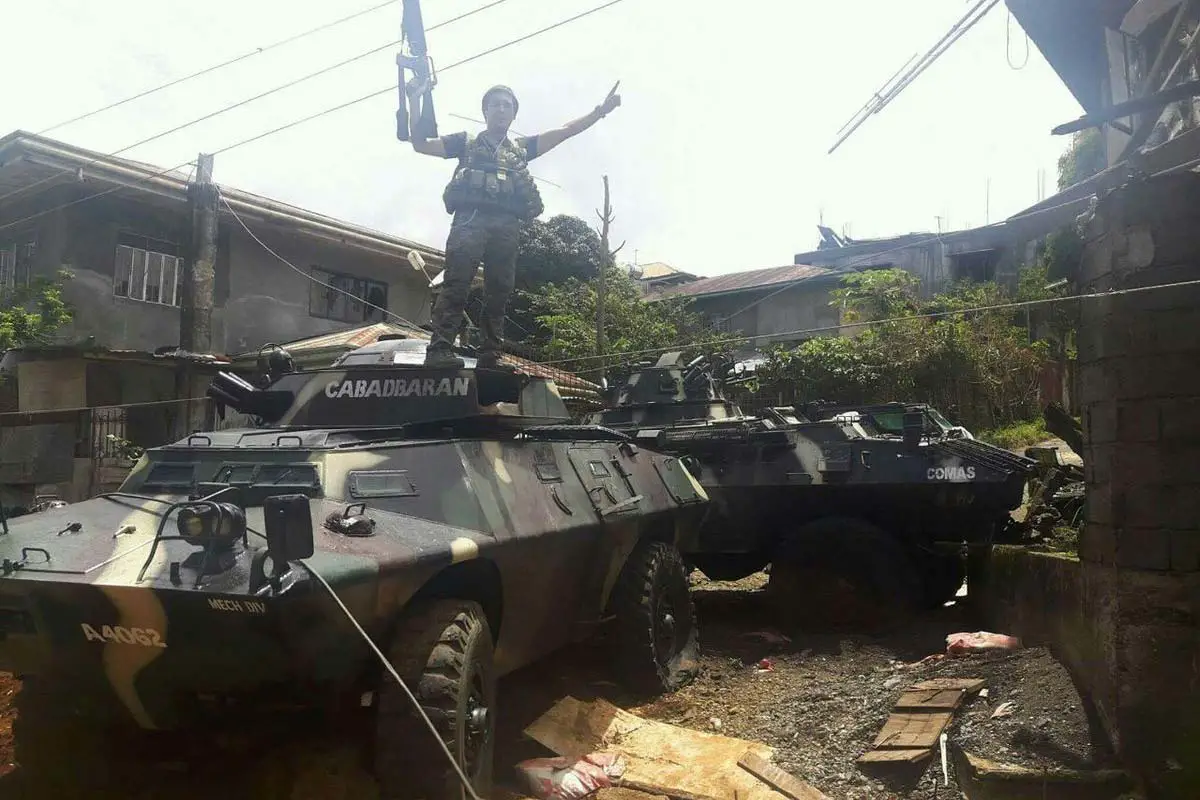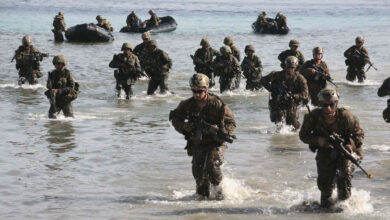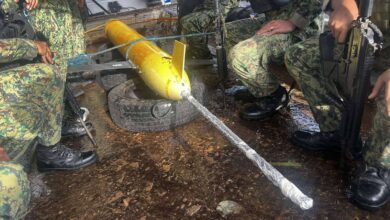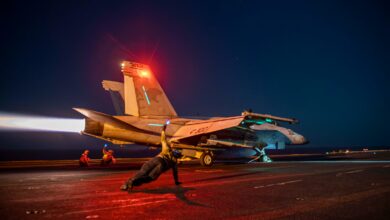Philippines: 100 foreign fighters joined ISIS in Mindanao since the Marawi battle
Foreign fighters from 16 countries have traveled to Mindanao and joined Islamic State East Asia affiliate groups
KUALA LUMPUR, Malaysia – Foreign militants continue to flow into the southern Philippines, with more than 100 entering Mindanao since the end of the battle of Marawi, a Philippine terrorism expert told The Defense Post.
A year after Marawi city was recaptured from the clutches of militants, the southern Philippines remains an attractive destination for foreign fighters, and neighboring nations remain concerned that many issues relating to their citizens who were killed in the five-month battle have yet to be resolved.
More than 1,200 people, including around 900 militants, were killed in the battle that erupted on May 23, 2017 after Islamic State-affiliated groups took control of the city. Marawi was reduced to an utter ruin in five months of clashes between the Philippine security forces and militant groups, the country’s worst urban conflict.
Philippines President Rodrigo Duterte, who announced the official conclusion of the battle on October 23, 2017, later vowed not to let such an endeavor by militants happen again.
Last week, The Defense Post exclusively reported that the Armed Forces of the Philippines had identified 32 foreign fighters among militants killed in Marawi. At least two of those appeared to be children.
But a Philippine terrorism expert said the security situation is not getting better as foreign militants continue to stream into Mindanao, the country’s largest southern island.
“Since the liberation of Marawi until now, some 100 foreign fighters have entered Mindanao,” Chairman of the Board of the Philippine Institute for Peace, Violence and Terrorism Research Professor Rommel Banlaoi told The Defense Post, citing information he received from Philippine security and defense agencies.
“They have come to Mindanao to join several ISIS-affiliated groups,” Banlaoi said.
Most of the militants are from neighboring Indonesia and Malaysia, but there are also people from Saudi Arabia, Turkey, Morocco, Spain, France, Tunisia, Iraq, Somalia, Egypt, Yemen, Libya, Pakistan, Bangladesh and China, he said.
“At least 60 of them have been identified by the Philippine authorities, and about 30 more [remain] unidentified,” Banlaoi said. “They often pretended to be tourists, businessmen, students and foreign workers.”
“Some who used the airports did not reach Mindanao,” said Banlaoi, who is also president of the Philippine Center for Intelligence and National Security Studies. “More than 10 of them were arrested, denied entry and deported mainly from the Manila and Clark international airports. Some are currently being detained. Others were able to proceed to Mindanao.”
Banlaoi said he cannot yet discern patterns in the new arrivals.
“I don’t have the basis to say whether the arrivals are steady, increasing or decreasing because much information about arrivals is not reported, monitored or discovered,” he said.
“All I can say is that the arrival of foreign fighters to southern Philippines continues despite arrests, detentions and deportations of others by the Philippine law enforcement authorities.”
This new figure of foreign fighter arrivals is around double the 48 the military estimated were in the country in January, when Major General Fernando Trinidad, then the Philippine military’s deputy chief of staff of intelligence, said foreigners were actively taking part in the training of terrorist recruits in Mindanao.
Trinidad claimed that 15 foreign fighters from Malaysia and Indonesia entered Mindanao in November last year, moving to Sarangani province to help the Maute group, one of the Philippine jihadist groups that is now part of Islamic State East Asia.
He said another 16 Indonesian militants had entered Mindanao to provide assistance and training to the ISEA-affiliate Abu Sayyaf group in Basilan and the Maute group in Lanao del Sur province.
Both groups were involved in the five-month battle with troops in Marawi city.
Banlaoi said local terrorist fighters welcome the foreigners because they provide funds and training, although they can learn from each other.
“The foreign militants also strengthen the global network of the local terrorists,” he said.
American University terrorism researcher Munira Mustaffa said people still go to Mindanao because they feel compelled to do so and feel the need to fulfil the group’s ambition and so-called prophecy.
“That the actual fighting is still ongoing presently in Mindanao gives them a sense of purpose, as opposed to Malaysia and Indonesia, where it’s just urban plotting,” Malaysian Munira told The Defense Post.
“I think having a guerilla-style siege in an urban setting such as Kuala Lumpur is not doable, considering the conditions i.e. the politics and security apparatus’ efficiency. In terms of proximity, it’s a lot easier and more convenient for them to reach Mindanao through various points and means.”
Sidney Jones, director at the Jakarta-based Institute for Policy Analysis of Conflict, believes care has to be taken with information from the AFP such as the number of newly arrived foreign fighters.
“This is especially when there isn’t a single concrete case of a foreign fighter who has arrived in the last few months,” Jones told The Defense Post.
“In August, there was a posting on ISIS media showing a camp of the Sawadjans in Sulu with fighters who were clearly foreign with one of them looking South Asian, but we don’t know when the photo was taken,” she said, referring to a family which leads an Abu Sayyaf faction.
Concerns over veteran militants entering the Philippines
International Islamic University of Malaysia deradicalization expert Ahmad el-Muhammady said it is important to determine whether the fresh arrivals are experienced fighters.
“Veterans especially from conflict areas like in Syria are capable of sharing their hard-learned skills such as making improvised bombs,” el-Muhammady, who is also an advisor to the Malaysian government, told The Defense Post. “It only takes one such an expert to bolster a terror group.”
“He can train more militants to become bomb makers, who in turn can pass on their knowledge yet to others. Bomb-making skills are the hardest to acquire. It’s a matter of life and death just to learn them, what more to share and actually use them.”
Terrorism analyst Pawel Wójcik said the non-Southeast Asian new fighters who made it to ISIS-affiliated groups across the southern Philippines are more likely to be inexperienced as they have been following the ‘hijra route’ that comes with the newly established ISEA wilayat, or province.
“Most of the experienced ones will be the regional fighters, from Malaysia and Indonesia, as usually they possess an actual militant past, connected to al-Qaeda or ISIS-aligned cells, with bomb-making capabilities and ideological backgrounds,” Wójcik told The Defense Post.
“Some are former [Indonesian terror group] Jemaah Islamiyah members, learning from the bomb-makers belonging to the al-Qaeda entity that has fought in Afghanistan and other theaters, but most obtained the skills by collaboration with the Abu Sayyaf or from ISIS-affiliated teams in Indonesia, especially in Poso (in Sulawesi, Indonesia], where the MIT [Mujahidin Indonesia Timur] has been operating.”
Wójcik said there also is the threat of returning fighters with skills from ISIS Central that would hugely improve the capabilities of the new ISEA wilayat.
“Also, some know-how sharing has already occured, as we witnessed in the Indonesian bombings in the recent two years, where IS affiliates used the kind of improvised bombs used in the Middle East,” he said.
Wójcik was referring to the bombings that included the latest ones in Surabaya, Indonesia in May in which 28 people including suicide bombers, who had used improvised explosive devices, were killed.
Old problems remain unresolved
The Philippines is now facing the issue of newly arrived fighters in addition to an earlier problem: many foreign fighters from the Marawi battle are still unaccounted for.
This writer reported for Free Malaysia Today last year that some 80 foreign fighters, mainly from Indonesia and Malaysia, were involved in the Marawi clashes.
Wójcik pointed out in that report that Western madia had mistaken “foreign fighters” in Marawi as those from Europe and the Arab world. Most of the foreign fighters in the Marawi war were from Indonesia and Malaysia, which Wójcik calls “regional fighters.”
The Terrorism Research and Analysis Consortium was also quoted in the report as saying that it believed more than 30 Malaysian fighters had been in Marawi, accounting for almost half the total figure of foreign terrorists.
TRAC said the figure was based on their monitoring of chatter on ISIS-related communication channels.
The Defense Post reported in September that this year had seen previously unprecedented attempts by Europeans trying to join ISIS in the Philippines, with some successfully making the journey. Although only a handful of Europeans have succeeded, the risk that this is the beginning of a larger trend should be a concern for the Philippines, nearby nations, and Europe.
El-Muhammady told The Defense Post the information that fresh foreign terrorists from Europe, the Arab world and the Southeast Asian region underlines the need for a better counterterrorism cooperation between Asean nations and their European and Arab counterparts.












